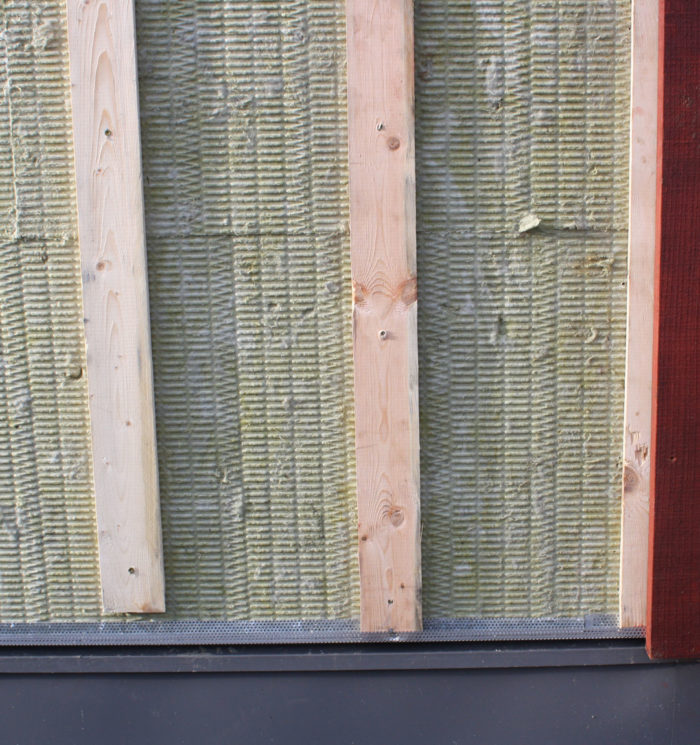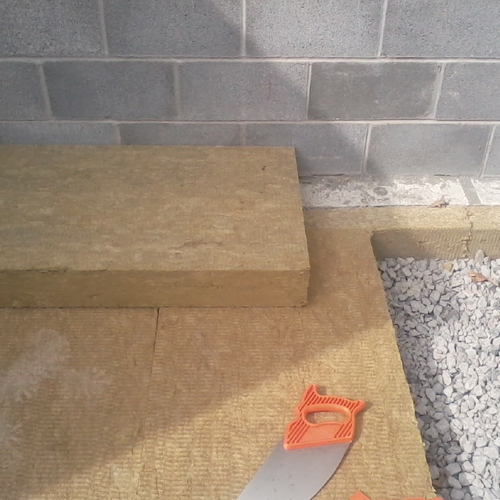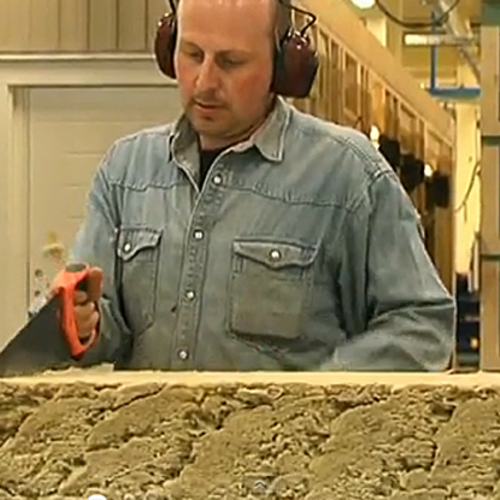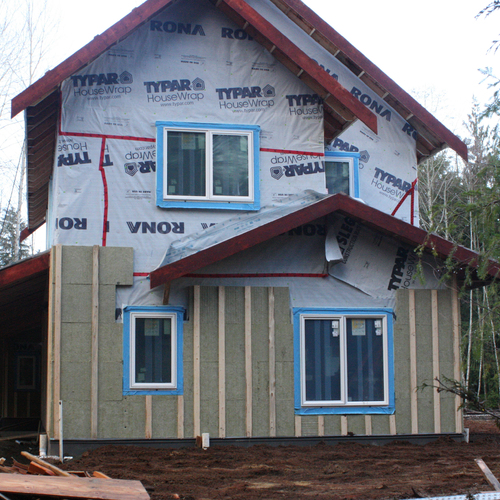
Image Credit: Image #1: Patrick Walshe
Fibrous insulation materials like mineral wool do not stop air flow. Unlike rigid foam (which is a pretty good air barrier, as long as the seams between panels are taped), mineral wool can only slow down air flow, not stop it.
So what happens when builders install mineral wool insulation on the exterior side of wall sheathing? Is the thermal performance of the mineral wool degraded by wind?
This question comes up every now and then on GBA. (See, for example, the dialogue between Lucy Foxworth and Lucas Durand in 2013.) While readers have speculated that semi-rigid mineral wool is (because of its relatively high density) fairly immune to the effects of windwashing — especially when compared to fiberglass, which is much less dense — the speculation hasn’t been backed up by measurements or calculations.
Now, however, thanks to a group of researchers from Ontario, including Randy Van Straaten and John Straube, we have enough data to reach a conclusion on this issue. In their recently published paper, “Wind Washing Effects on Mineral Wool Insulated Sheathings,” the researchers came to the following conclusion: for mineral wool insulations with a density of 4.4 pounds per cubic foot or more, the windwashing effect on the thermal performance of the insulation is “small and practically negligible for design considerations.”
Use of continuous insulation on the exterior side of sheathing is increasing
Straube presented his paper at a recent building envelope conference in Clearwater Beach, Florida. (The conference had the most inelegant and ungainly name ever devised: the “Thermal Performance of the Exterior Envelopes of Whole Buildings XIII International Conference.”)
Straube began his presentation by defining windwashing: “Windwashing is the phenomenon whereby outdoor air goes through the insulation, and then goes out again.”
Straube noted that it’s becoming increasingly common for builders to install continuous insulation on…
Weekly Newsletter
Get building science and energy efficiency advice, plus special offers, in your inbox.

This article is only available to GBA Prime Members
Sign up for a free trial and get instant access to this article as well as GBA’s complete library of premium articles and construction details.
Start Free TrialAlready a member? Log in















12 Comments
Great info
I've avoided exterior mineral wool mostly because it is such a huge pain, but wind washing was also a concern. Ah well, perhaps I'll get stuck doing it after all! Thanks a lot, pal.
Mineral Wool
Price and availability are all that are holding mineral wool back from general use. It's a great material.
Cost Comparison?
Is there any published data comparing the installed cost of rigid foam versus the installed cost of Comfortboard IS?
Response to Kevin Camfield
Kevin,
Construction costs are intensely local. Mineral wool costs are more variable than other construction materials, because distribution is spotty, and some distributors require minimum orders that are quite large. So you have to do your own research on that issue.
On average, rigid foam is cheaper than mineral wool. If you are able to find a local source for used (reclaimed) rigid foam, then the rigid foam option will be less expensive by a significant factor.
Pain to work with
I can't imagine trying to keep a flat plane for siding using furring strips over mineral wool, seems like more of a hassle than its worth. I know some builders are trying to construct vapor open wall assemblies but I can buy 2" thick sheets of EPS foil faced from Lowes for $25, much easier to work with and not itchy.
Mineral wool board compressibility
Not having even seen a sheet of Roxul mineral fiber board, I can only speculate on its properties. I imagine it has the density of the old Fir-Tex fiberboard, one of the early generation of insulating boards, Fir-Tex was not difficult to work with and, while not hard surfaced or rigid, was also not highly compressible and being lightweight. was easy to throw around. My take is that Roxul Comfortboard is similar and that furring, especially 1x4, would not overly compress the board. Of course, there is always laser planing as a back-up strategy.
Living in the Marine 4 zone and within walking distance of the Pacific Coast trail, there is one word for not using foam in any form or thickness: ants. Once carpenter ants make a tunnel in foam insulation it is all over. Resistance is futile. For one thing, the appearance of ants will not be immediately obvious and by the time they are noticed they have established a colony and have moved to the attic. Controlling ants is not easy and eradicating a colony can take months, if not years. And that is with professional help. I can testify to that having lived through a fire ant home invasion.
That is why I am going with mineral wool board for my whole house renovation. My hope is that ants don't tunnel through reclaimed rock like they would through foam or Fir-Tex, and the board is dense enough to discourage an inquisitive ant.
I know that Straube, et.al., are fans of Roxul, but the mineral wool boards do have some properties that make them the right choice in the right place. The only problem seems to be getting your hands on it in the first place.
Jeffrey
https://www.greenbuildingadvisor.com/blogs/dept/qa-spotlight/if-ants-rigid-foam-should-we-stop-using-it
Jeffrey
Winroc in Nanaimo stocks it regularly, and they are going to start keeping a much larger stock of it on hand. At this point, it is still good to place your order at least 5 weeks in advance if you are going to need a full house worth (2000+ sq. ft.). I know the Winroc in Victoria often steals our supply from Nanaimo, so you should be able to get it from them too, which sounds like it might be closer.
Using 1x4 cedar strapping as rainscreen, you will find that you can compress the strapping up to about a half an inch at the ends of your rain screen pieces, or at the edges of a sheet of the Comfortboard. Continually checking your walls with a long straight edge across their width and height is a must, fine-tuning your screws in and out to ensure that everything stays co-planar. Not that fun, but not the end of he world. Believe me, I have tried to think of every possible way to incorporate spacers, or compression blocks or other methods to allow one to suck the strapping tight against some kind of spacer, but have had, or heard of, no success in coming up with anything economical or quick. I've resigned to the nuisance of checking with a straight edge. In dozens of full house wraps with the stuff, we have never had a single issue with cladding ending up being "wavy" looking, so it's not as big of a problem as it seems. Good luck with a great product!
Is exterior mineral wool worthwhile in zone 4B?
My wife and I are working with a design/builder on a new construction project in Silver City, NM. Rather than adobe or pumic-crete (both of which are realistic options in our area) we have decided on 2*6 framing, blown-in cellulose, an inch or so of continuous insulation exterior of the sheathing, and fiber cement siding. I have read several GBA articles discussing mineral wool insulation, and am considering the additional expense as compared to rigid foam. Unfortunately, zone 4B just isn't mentioned in any of the articles I've found.
Our design/builder has not worked with semi-rigid mineral wool, but has not dismissed the idea. His initial concern is the additional expense of the vertical strapping (rain screen gap) as opposed to attaching the siding directly to foam.
Questions:
Is semi-rigid mineral wool (Roxul Comfortboard 80) well suited for a mixed/dry climate, and is the additional cost worthwhile? Whether or not we choose mineral wool over foam, would it benefit us to have the rain screen gap?
We have seen several projects recently completed using cement fiber board installed without primer or paint. I am not sure what the siding was installed over or if a rain screen gap was included. The siding is visibly saturated after heavy rain, but seems to dry out without issue. Could this possibly hold up over time?
Response to Aaron Beckworth
Aaron,
I think that it's always better to install fiber-cement siding over a rainscreen gap rather than to fasten fiber-cement siding directly to rigid foam. For more information on this issue, see All About Rainscreens.
Most builders find it easier to install rigid foam rather than mineral wool on the exterior side of wall sheathing. The biggest challenge is keeping the furring strips co-planar; that can be tricky in light of the squishiness of mineral wool. But if you have a compelling reason to prefer mineral wool to rigid foam, go ahead with your plan. Plenty of builders have had success with exterior mineral wool.
Does anyone have experience with other rigid air-permeable insulation, such as Hempwool? I’m guessing that wind washing would have a greater effect on the r-value since, according to it’s manufacturer (Hempitecture), it’s density is 2.18 lbs/cubic ft. Technical data sheet attached.
Questions:
1. Can we make an accurate windwashing comparison between hemp and mineral fiber density since hemp fibers weigh less to begin with?
2. Would adding a WRB external to the Hempwool help to mitigate any windwashing effect?
By the way, I’ve never worked with it and don’t know if external installation would be a nightmare. But it might be worth it to me to find a product that is even less energy intensive to manufacture (and more carbon sequestering) than mineral wool.
Thanks for the help!!
Adam,
You can probably get a fair idea by extrapolating from the various materials in tables 8 and 9.
https://www.rdh.com/wp-content/uploads/2017/10/Van-Straaten-Windwashing.pdf
To my mind, none of the materials, including fiberglass or mineral wool batts, suffer enough degradation to worry about.
Adding a WRB outside the insulation would go a long way to mitigate any losses.
Log in or become a member to post a comment.
Sign up Log in